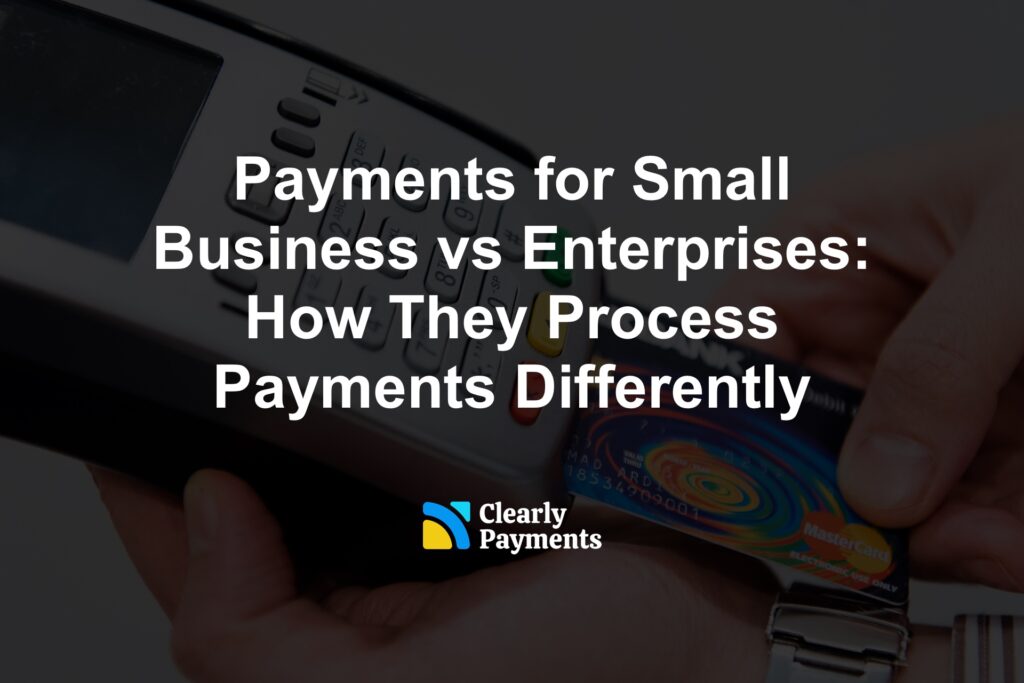Payment processing is a major part of business operations, influencing cash flow, customer satisfaction, and overall efficiency. However, the methods and preferences for processing payments vary between small businesses (SMB) and large enterprises.
This article explores these differences in the USA and Canada for small business vs enterprise payment processing.
Summary of SMB vs Enterprise Payments
Here’s a table summarizing the key differences between small businesses (SMBs) and enterprises in payment processing:
| Aspect | Small Businesses (SMBs) | Enterprises |
|---|---|---|
| Percent of Businesses that Accept Cash | 64.4% (5-19 employees), 44.9% (1-4 employees) | 49.4% (100+ employees) |
| Percent of Businesses that Accept Cheque | 68.1% – 72.9% | Similar to SMBs |
| Percent of Businesses that Accept EFT (Electronic Funds Transfer) | 57.6% (1-4 employees) | 74.7% (100+ employees) |
| Percent of Businesses that See Fees as a Barrier | 21.6% (1-4 employees), 25.4% (5-19 employees) | 12.7% (100+ employees) |
| Percent of Businesses that Focus on Security Concerns | 12.7% (smallest businesses) | 29.3% (100+ employees) |
| Percent of Businesses Concerned about Credit Card Processing Fees | 78% of SMB owners find them unaffordable | Generally able to negotiate lower fees |
| Contactless Payment Growth | 55% increase in SMB adoption | Standardized across enterprises |
| Revenue from Card Payments | 50% of total sales | Higher, often >70% |
| Revenue from Cash Payments | 36.4% of total sales | Lower percentage |
| Interac e-Transfer Acceptance (Canada) | 63% of SMBs | Higher due to automated payment systems |
| Mobile Payment Apps Acceptance | 49% of SMBs | Standard in most large enterprises |
| Plan to Go Fully Cashless | Only 8% of SMBs | Higher likelihood, especially in e-commerce |
Payment Methods Accepted
Small and medium-sized businesses (SMBs) often have diverse payment acceptance practices compared to larger enterprises. In the U.S., 81% of small businesses accept credit and debit cards, while 37% accept digital wallets such as Apple Pay and Google Pay. Cash remains an essential payment method for many SMBs, with 36.4% of total sales still being cash-based. Larger enterprises, however, are more likely to integrate advanced electronic payment systems, including ACH transfers and custom corporate payment solutions.
In Canada, a similar trend exists. According to Statistics Canada, 64.4% of businesses with 5 to 19 employees and 65.0% of those with 20 to 99 employees accepted cash payments. Larger businesses (100 or more employees) were more inclined to accept electronic funds transfers (EFT) at 74.7%, compared to 57.6% among the smallest businesses (1 to 4 employees).
Payment Terminal Usage: SMB vs. Enterprise
The type of payment terminal a business uses is influenced by transaction volume, security requirements, and integration capabilities. Small businesses and large enterprises often rely on different types of terminals:
Small Businesses:
Typically use standalone terminals such as Square, Clover, or traditional countertop POS systems.
Prefer mobile and wireless solutions that support contactless payments and QR codes for flexibility.
Tend to opt for simpler, cost-effective devices that require minimal setup and maintenance.
May lack integration with complex inventory management or customer relationship systems.
Enterprises:
Utilize integrated point-of-sale (POS) systems that connect with inventory, customer data, and analytics tools.
Invest in multilane terminals, self-checkout kiosks, and custom-built hardware solutions.
Require higher security standards, including EMV, PCI compliance, and encryption measures.
Often have custom-built payment gateways to handle higher transaction volumes and specialized needs, such as recurring billing or international payments.
This distinction highlights how small businesses prioritize affordability and ease of use, while enterprises focus on scalability, security, and data integration.
Factors Influencing Payment Method Adoption
The shift towards digital payment methods has heightened the financial burden on small businesses due to credit card processing fees. In the U.S., many small business owners face transaction fees of 2.5% to 4% per sale, which adds up significantly over time. Some states have pushed for regulatory action to cap these fees or introduce surcharge transparency requirements.
A survey by the Canadian Federation of Independent Business (CFIB) revealed that 78% of Canadian business owners find these fees unaffordable. The pandemic accelerated the move away from cash, with 92% of businesses now accepting debit/credit cards and 55% increasing their acceptance of contactless payments. However, this transition has led to higher costs, prompting calls for reduced fees and more transparent contracts from payment processors.
Impact of Credit Card Fees on Small Businesses
The choice of payment methods among businesses is influenced by various factors, including service fees, security concerns, and compatibility with existing systems. Smaller businesses are particularly sensitive to service fees. In the U.S., nearly 68% of small businesses find credit card processing fees burdensome, which impacts their willingness to accept certain payment methods.
In Canada, over one-fifth (21.6%) of businesses with 1 to 4 employees and 25.4% of those with 5 to 19 employees cited service fees as a barrier to accepting certain payment methods. In contrast, only 12.7% of larger businesses (100 or more employees) reported service fees as a concern. Security or privacy concerns were more prevalent among larger businesses, with 29.3% expressing such worries, compared to 12.7% of the smallest businesses. (www150.statcan.gc.ca)
Revenue Distribution by Payment Type
The composition of sales by payment method also differs between small businesses and larger enterprises. A study by Mercator Advisory Group indicated that, on average, card payments accounted for 50% of total sales in U.S. small businesses, cash for 36.4%, and checks for 30.1%.
In larger enterprises, electronic payments dominate, particularly for B2B transactions, where ACH and wire transfers account for a significant portion of total revenue.
Merchant Acceptance Trends
Despite the growing prevalence of digital payments, cash acceptance remains high among small and medium-sized businesses in both the U.S. and Canada. Key findings include:
Canada:
96% of SMBs continue to accept cash.
Debit and credit card acceptance stands at 89%.
63% of businesses accept Interac e-Transfer.
49% of merchants accommodate mobile payment apps.
92% of merchants have no plans to transition to a cashless operation in the near future.
United States:
81% of small businesses accept credit and debit cards.
37% of small businesses accept digital wallets such as Apple Pay and Google Pay.
66% of businesses prefer digital payments over cash transactions due to security and convenience.
41% of SMBs are considering reducing or eliminating cash transactions within the next five years.
These insights indicate a balanced approach to payment acceptance, with businesses maintaining flexibility for different payment preferences while gradually shifting towards digital transactions.




